Environmental Justice a Key Theme Throughout Biden’s National Climate Assessment
WASHINGTON—Whether it’s the likelihood of living in a flood zone, lacking access to parks or having fewer resources to recover from a destructive storm, the consequences of climate change are not experienced equally in the United States. That’s a key message from some of the nation’s leading climate scientists, public health experts and economists in a landmark federal report released Tuesday.
It’s the first time a National Climate Assessment, the federal climate report mandated by Congress under the Global Change Research Act of 1990, has placed such a heavy emphasis on the concept of environmental justice—that low-income families and communities of color have historically borne the brunt of the nation’s environmental harms while benefiting least from environmental regulation.
To coincide with the release of the report, the administration announced $6 billion in federal investments into new and expanded programs to reduce flood risk, advance environmental justice, and bolster the aging U.S. electric grid—money that Congress previously made available in the 2021 bipartisan infrastructure act and other legislation.
The report, which comes out at least once every four years, compiles the latest peer-reviewed studies and other relevant research on climate change into a comprehensive and easily-digestible document for U.S. policymakers. Similar to the United Nations’ IPCC report on the global level, the National Climate Assessment is considered the nation’s single-most authoritative document on how global warming is affecting the country.
Previous assessments, including the 2014 report released under President Barack Obama and the 2018 report released under President Donald Trump, often approached the inequitable outcomes of the climate crisis as an afterthought, mentioning “social justice,” “climate justice” or “environmental justice” just a little over a dozen times total in documents that were hundreds of pages long.
By contrast, the Fifth National Climate Assessment discusses social, economic and health inequities throughout the entire report and even dedicates a chapter to “social systems and justice,” noting that societal factors, including historic racism, have shaped the climate reality experienced by many low-income families and communities of color today.
“For example, areas that were historically redlined—a practice in which lenders avoided providing services to communities, often based on their racial or ethnic makeup—continue to be deprived of equitable access to environmental amenities like urban green spaces that reduce exposure to climate impacts,” the report’s authors wrote. “These neighborhoods can be as much as 12 degrees Fahreinheit hotter during a heatwave than nearby wealthier neighborhoods.”
The report’s sharp focus on environmental justice issues surprised Maria Lopez-Nunez, deputy director of the New Jersey-based social justice advocacy group Ironbound Community Corporation in Newark, and a member of the White House Environmental Justice Advisory Council. Lopez-Nunez, who lives in a neighborhood surrounded by heavy industry, sewage plants and the state’s biggest shipping hub, said she had largely written off past climate assessments because she believed they failed to properly acknowledge the reality of neighborhoods like hers.
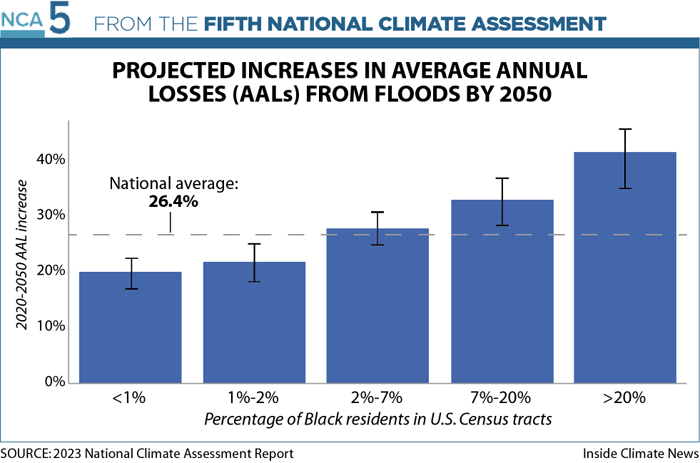
Newark’s Ironbound neighborhood has some of the most polluted air in the state and lacks the kind of green space and tree cover found in more affluent parts of the city and its surrounding suburbs. That means the area often experiences flooding because the rainwater has nowhere to go, the floodwaters can carry toxic materials leached from nearby industrial plants and the heatwaves feel more oppressive due to a lack of shade, she said.
Lopez-Nunez welcomed Tuesday’s assessment, saying she hopes policymakers pay attention to its message. “It was almost like it would never happen, but better late than never,” she said. “It’s gonna go a long way to helping the climate assessment feel a lot more relevant to the average person.”
Disproportionate Health Impacts
Christal Heath was born in a section of South Philadelphia’s Grays Ferry neighborhood that is called the Forgotten Bottom, close to what was one of the nation’s oldest oil refineries, which operated for a century and a half until it closed four years ago.
“I used to see the smokestacks with the fire and everything,” said Heath, 58, an organizer for the nonprofit Philly Thrive who has asthma, and remembers watching the pollution’s impact on her mother, a community organizer, who died of breast cancer in 2013 at the age of 80. “All kinds of chemicals are in the air and we breathe it in every day. We’ve been breathing it since the first factory and the first car was built.”
The plight of families like Heath’s is a major theme throughout the Fifth National Climate Assessment. While the report details how the adverse effects of climate change threaten all communities, it spotlights how “health-related burdens are experienced more acutely by BIPOC”—Black, Indigenous and people of color—“and low-wealth communities that have been under-resourced and overburdened.”
Although the South Philadelphia smokestacks have been torn down, federal officials say the impact of pollution’s harms there and in fenceline communities like it continue to disproportionately affect people of color, the poor, and children.
In addition to the effects of systemic racism and discrimination, the assessment also found that the harmful effects of climate change on human health can be seen in an increase in heat-related deaths, changes in the distribution of infectious diseases (cases of Lyme disease have increased sharply over the last 20 years largely because of climate, the assessment notes), poor water quality, and incidences of wildfire and drought.
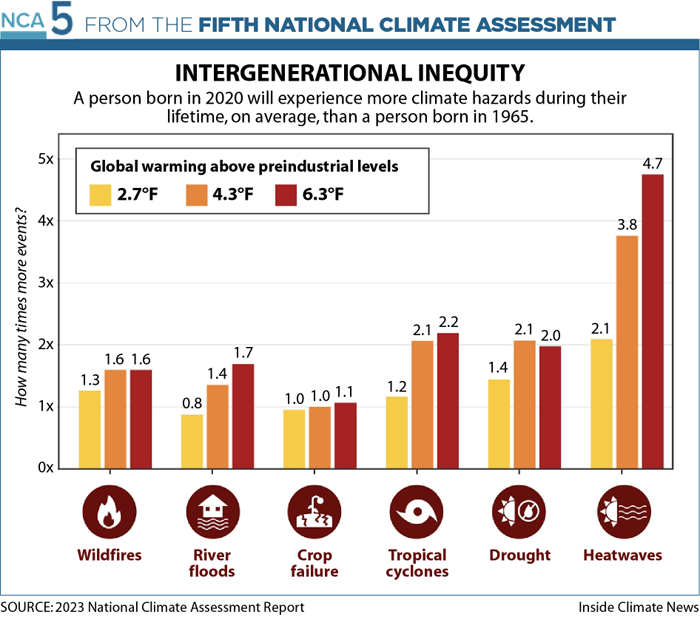
The report also found that extreme weather events “can contribute to adverse mental health outcomes” because of such factors as forced displacement, trauma, lost livelihoods and disrupted social support networks. One out of six low-income mothers who survived Hurricane Katrina in 2005 were still experiencing trauma more than a decade and a half later.
Robert Dubrow, director of the Yale Center on Climate Change and Health, Environmental Health Sciences, said he believes that documenting these adverse mental health outcomes after weather events could move the needle and accelerate the kind of policy changes needed to address the ills of climate change.
“I think it’s important to document the full extent of how the disasters have affected people. The more people understand the adverse effects, at least theoretically, you’d think the more likely that there would be action.”
The report also notes that “implementing timely, effective, and socially appropriate adaptation measures, creating climate-resilient health systems, and preventing the release of greenhouse gases can protect human health and improve health equity.” Those measures, the assessment says, include increasing disease surveillance, creating mechanisms to mitigate the effects of extreme weather, and reducing air pollution.
The latter, the report suggests, should be a particular priority for those in fenceline communities like Crystal Heath.
“African Americans and individuals with low incomes face higher risks of death from climate-driven floods and air pollution compared to white people,” the assessment notes. “People of color are disproportionately exposed to greenhouse gas co-pollutants like small particulate matter and face adverse health impacts as a result.”
The new report is the first National Climate Assessment to trace such exposure to “housing discrimination and redlining”—the long-standing practice of denying people of color home loans in certain neighborhoods before the enactment of fair housing laws.
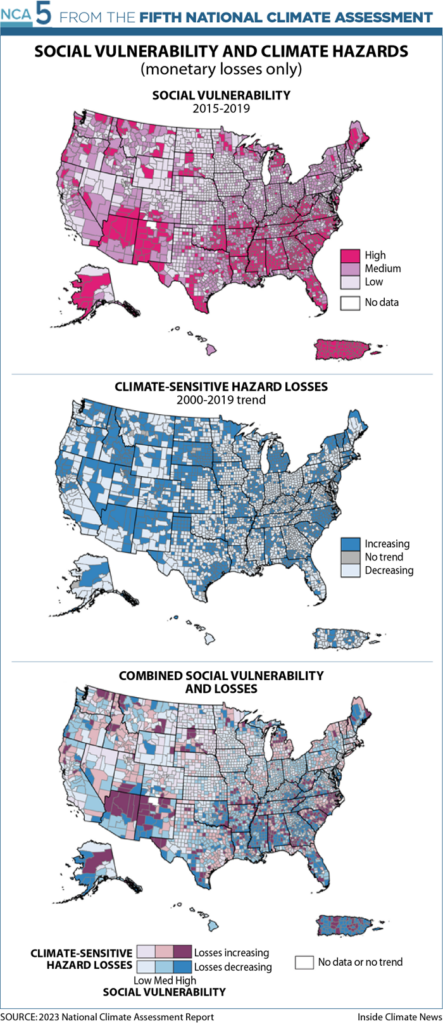
Those conditions have led to concentrations of people of color and those with low incomes in fenceline communities—residential areas that are adjacent to industrial sites—places like the Forgotten Bottom in South Philadelphia, also known as Grays Ferry, one of the “redlined” areas on the original 1937 home loan appraisal maps that essentially codified discriminatory lending. Redlining had a particularly devastating effect on Heath’s hometown—according to data from Brown University: among the nation’s 10 largest cities, Philadelphia is second only to Chicago for the highest level of residential segregation between Black Americans and their white counterparts.
One of the authors said she constantly thought about generations to come in such neighborhoods while writing the Fifth National Climate Assessment.
Kristie L. Ebi, an author and professor at the Center for Health and the Global Environment at the University of Washington department of global health, said she hopes that “the decision makers, the policymakers who read this are compelled to up their ambition to initiate new programs.”
She added that she wants the assessment to “ultimately help drive the policies and the individual actions we know are needed to help protect human health and well-being in a changing climate.”
The Path to Indigenous Climate Justice
Long before the United States existed, hundreds of Indigenous communities and tribal nations inhabited the coasts, plains, mountains, forests, swamps and deserts of the continent they call Turtle Island. They developed cultural and spiritual practices, passed on through stories since “time immemorial,” based on intimate observations and relationships with the local ecosystems that sustain them and the nonhuman beings they consider kin.
The ability to harness that traditional knowledge through self-determination is the key to ensuring Indigenous people’s resilience to climate change, the authors of the new report’s chapter on Tribes and Indigenous Peoples make clear. And they explore how federal, state and local government officials’ failure to honor Indigenous and tribal sovereignty, combined with the enduring consequences of genocide, extractive colonialism and land dispossession, have eroded Indigenous peoples’ right to control climate change responses in their own communities.
“Most Indigenous peoples have complicated stories to tell about anthropogenic climate change that often start with their being harmed by fossil fuel industries,” writes chapter lead author Kyle Whyte, Potawatomi Nation citizen and University of Michigan philosophy professor, in an essay in the book Climate Futures.
Oil development and unhinged settler greed in the early 1900s led to the murder of scores of Osage people with impunity, Whyte noted in his essay, a traumatic history retold in the film and book, “Killers of the Flower Moon.” The NCA notes the continued struggle of indigenous communities for protection of their land and water from industry, including energy companies, and although the report does not give specifics, it includes footnotes to books on the Standing Rock Sioux tribe’s fight against the Dakota Access pipeline.
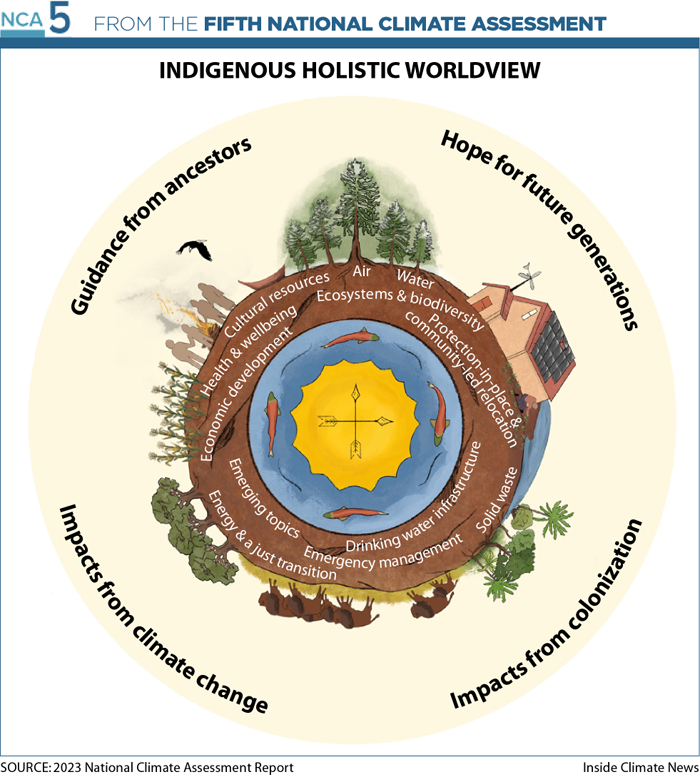
The report explores how climate change has compounded industrial colonialism’s assaults on the health and traditions of Indigenous peoples. Climate-induced sea level rise and storm surges endanger coastal tribes’ sacred sites, burial grounds and culturally important foods. Climate change threatens tree species used to make totem poles, lodges and basketry. Changes to the Alaskan Arctic sea ice appear likely to make certain Iñupiaq words obsolete.
Throughout the NCA, there are examples of how traditional “knowledge holders,” who closely track natural cycles in the land, water, sky and ecological communities, are uniquely equipped to craft place-based strategies to adapt to the destabilizing consequences of a fossil fuel economy.
The Hopi’s dry-farming techniques, fine-tuned over millennia in the arid Southwest mesas, offer lessons for coping with more frequent and severe drought. The Karuk Tribe’s tradition of “cultural burns” to manage their fire-evolved California lands is a model for reducing fire hazards. Washington’s Swinomish Indian Tribal Community is building “clam gardens” to adapt to sea level rise and ocean acidification and bolster food security.
Expanding such Indigenous-led efforts to address climate change will require increased investment from federal and state governments, the authors of the chapter argue. But most critically, it depends on ensuring Indigenous sovereignty and self-determination to ensure that communities can steward the land through cultural practices refined over millennia.
From Field to Food Bank
Previous reports have focused mostly on the damage climate change will inflict on agriculture, but the new U.S. assessment makes a remarkable shift by addressing climate-related impacts along the entire food system, from field to food bank.
It makes a striking acknowledgement of agriculture’s contribution to climate change, particularly from meat production and monoculture crops.
“This chapter takes a very big jump from the last one,” said Omanjana Goswami, an interdisciplinary scientist with the Union of Concerned Scientists and a review editor of the agriculture section.
Among other major changes, the authors say climate change will impact food security.
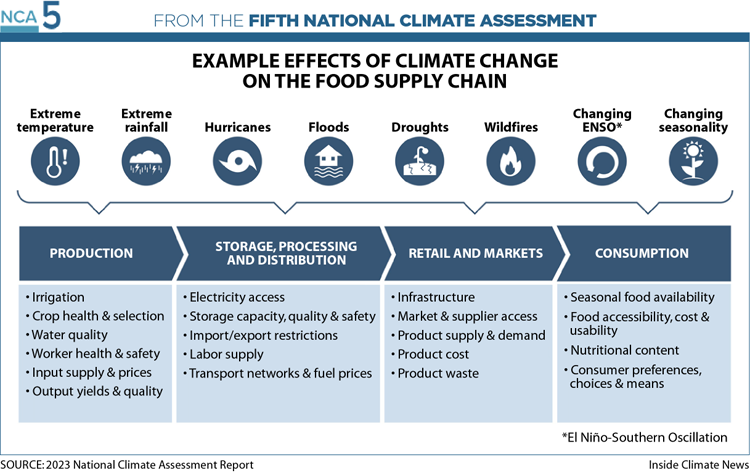
“We are now starting to feel climate impacts, not only in agricultural production but on the consumption end of things, and they’re not proportional,” Goswami said. “Vulnerable populations are facing more of the impact.”
The assessment says that climate change is clearly affecting American agriculture, which is getting increasingly battered by climate-fueled disasters.
The authors note that growing areas will migrate northward: The Department of Agriculture’s “plant hardiness” map forecasts that, by the end of the century, small parts of Alaska could be in the same growing zone as much of the deep south today.
The assessment emphasizes agriculture’s climate impact, most of which comes from cow belches—about 25 percent of all U.S. methane emissions. But the report also points out nitrous oxide emissions from heavy fertilizer use for major crops and even advocates “agroecological” practices, including more judicious fertilizer application.
Notably—and likely controversially—the assessment says that lowering beef consumption would reduce greenhouse gas emissions because of the outsized carbon footprint of beef production.
Global climate assessments, including from the Intergovernmental Panel on Climate Change, have advised similar dietary shifts, particularly for high-income countries. But U.S. reports and programs, including the Dietary Guidelines, the government’s official nutrition advice, have shied away from making such recommendations, largely because of pressure from the farm and cattle lobbies.
“This is the first time we’re seeing something like that being explicitly mentioned and published in a government-sponsored report,” Goswami said. “Clearly, you can’t think you’re going to meet climate targets without addressing the elephant in the room.”
Share this article
Disclaimer: The copyright of this article belongs to the original author. Reposting this article is solely for the purpose of information dissemination and does not constitute any investment advice. If there is any infringement, please contact us immediately. We will make corrections or deletions as necessary. Thank you.







